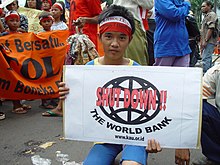Criticism

The World Bank has long been criticized by a range of non-governmental organizations and academics, notably including its former Chief Economist Joseph Stiglitz, who is equally critical of the International Monetary Fund, the US Treasury Department, and US and other developed country trade negotiators. Critics argue that the so-called free market reform policies – which the Bank advocates in many cases – in practice are often harmful to economic development if implemented badly, too quickly ("shock therapy"), in the wrong sequence, or in very weak, uncompetitive economies. World Bank loan agreements can also force procurements of goods and services at uncompetitive, non free-market, prices.:5 Other critical writers such as John Perkins, label the international financial institutions as 'illegal and illegitimate' and a cog of coercive American diplomacy in carrying out financial terrorism.
In Masters of Illusion: The World Bank and the Poverty of Nations (1996), Catherine Caufield argues that the assumptions and structure of the World Bank operation ultimately harms developing nations rather than promoting them. In terms of assumption, Caufield first criticizes the highly homogenized and Western recipes of "development" held by the Bank. To the World Bank, different nations and regions are indistinguishable, and ready to receive the "uniform remedy of development". The danger of this assumption is that to attain even small portions of success, Western approaches to life are adopted and traditional economic structures and values are abandoned. A second assumption is that poor countries cannot modernize without money and advice from abroad.
A number of intellectuals in developing countries have argued that the World Bank is deeply implicated in contemporary modes of donor and NGO driven imperialism and that its intellectual contribution functions, primarily, to seek to blame the poor for their condition.
Defenders of the World Bank contend that no country is forced to borrow its money. The Bank provides both loans and grants. Even the loans are concessional since they are given to countries that have no access to international capital markets. Furthermore, the loans, both to poor and middle-income countries, are at below market-value interest rates. The World Bank argues that it can help development more through loans than grants, because money repaid on the loans can then be lent for other projects.
Criticism was also expressed towards the IFC and MIGA and their way of evaluating the social and environmental impact of their projects. Critics state that even though IFC and MIGA have more of these standards than the World Bank they mostly rely on private-sector clients to monitor their implementation and miss an independent monitoring institution in this context. This is why an extensive review of the institutions' implementation strategy of social and environmental standards is demanded.
Allegations of corruptionedit
The World Bank's Integrity Vice Presidency (INT) is charged with investigation of internal fraud and corruption, including complaint intake, investigation and investigation reports.
Investmentsedit
The World Bank Group has also been criticized for investing in projects with human rights issues.
The Compliance Advisor/Ombudsman (CAO) criticized a loan given to the palm oil company Dinant by the World Bank after the 2009 Honduran coup d'état. There have been numerous killings of campesinos in the region where Dinant was operating.
Other controversial investments include loans for the Chixoy Hydroelectric Dam in Guatemala while it was under military dictatorship, and a loan to Goldcorp (then Glamis Gold) for the construction of the Marlin Mine.
In 2019, the Congressional-Executive Commission on China questioned the World Bank about a loan in Xinjiang, China that was used to buy high-end security gear, including surveillance equipment. The World Bank launched an internal investigation in response to the allegation. In August 2020, U.S. lawmakers questioned the continued disbursement of the loan.
Comments
Post a Comment